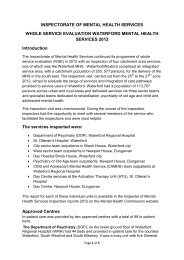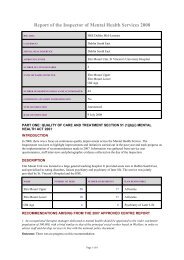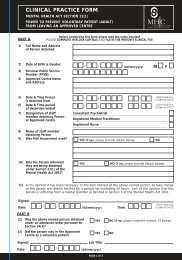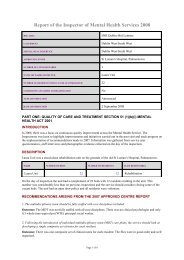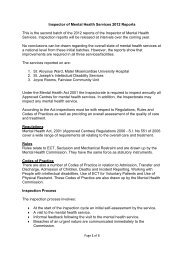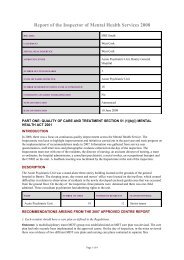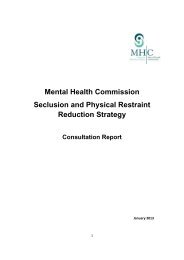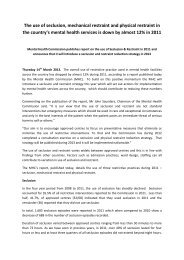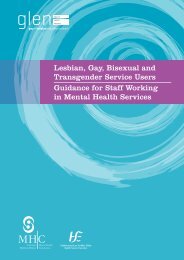a vision for a recovery model in irish mental health services
a vision for a recovery model in irish mental health services
a vision for a recovery model in irish mental health services
You also want an ePaper? Increase the reach of your titles
YUMPU automatically turns print PDFs into web optimized ePapers that Google loves.
A Qualitative Analysis of Submissions to the Mental Health Commission on the Discussion PaperA Vision <strong>for</strong> a Recovery Model <strong>in</strong> Irish Mental Health ServicesAdditional Suggestions or Criticisms∆ The Commission is referred to a “commendable” article by Sowers (2005).∆ Disparate aspects of the service pro<strong>vision</strong> (HSE/Independent Provider as well asvocational, voluntary bodies etc) should meet <strong>in</strong> a non-hierarchical exploratory contextof equality. One respondent 8 expressed a particular <strong>in</strong>terest <strong>in</strong> host<strong>in</strong>g or co-host<strong>in</strong>g a<strong>for</strong>um of this k<strong>in</strong>d.∆ Opportunities should be created <strong>for</strong> HSE/Independent Provider professionals to meetwith professionals who are work<strong>in</strong>g with the <strong>recovery</strong> <strong>model</strong>.∆ The “membership” of the committee and authors <strong>in</strong>volved <strong>in</strong> the preparation of thisdiscussion paper should be provided.∆ The Commission is referred to two notable submissions 9 that provide quite a detailedcritical review of the discussion paper.∆ The juxtaposition of the <strong>recovery</strong> <strong>model</strong> with the medical <strong>model</strong> was criticised 10 . (“Whycompare the <strong>recovery</strong> <strong>model</strong> only to the medical <strong>model</strong>? The paper disappo<strong>in</strong>ts <strong>in</strong>conspicuously ignor<strong>in</strong>g contemporary <strong>model</strong>s of care notably the bio-psycho-social<strong>model</strong> the established <strong>model</strong> <strong>in</strong> the tra<strong>in</strong><strong>in</strong>g and practice of many <strong>mental</strong> <strong>health</strong>professionals, the psychosocial rehabilitation <strong>model</strong> among others. Juxtaposed withany of the a<strong>for</strong>ementioned examples, the claimed uniqueness and radical nature of the<strong>recovery</strong> <strong>model</strong> is no longer apparent”).∆ Systematic research and evaluation of the <strong>recovery</strong> <strong>model</strong> should proceed and aim totease out the <strong>model</strong>’s <strong>in</strong>gredients and to what extent they are unique to the <strong>recovery</strong><strong>model</strong> or shared with others. A caution was offered that we need to be wary of“premature market<strong>in</strong>g of any particular <strong>model</strong>”.∆ The document refers ma<strong>in</strong>ly to schizophrenia and psychotic illness. A query was maderegard<strong>in</strong>g the applicability of the <strong>model</strong> across all of the illness spectrum <strong>in</strong>clud<strong>in</strong>g: careof the older person, children and adolescents, organic illnesses, personality disorders,dual diagnosis etc.8Roslyn Park College.9PNA (group response) & the Central Mental Hospital.10IMO,24




